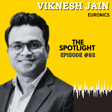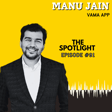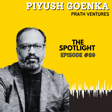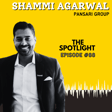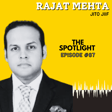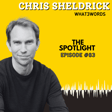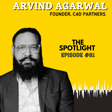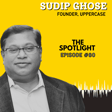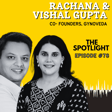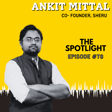Become a Creator today!Start creating today - Share your story with the world!
Start for free
00:00:00
00:00:01

Bridging the capital gap for SMEs | Harsh Pokharna @ OkCredit
OkCredit offers a free digital ledger solution along with financial products for the unorganised sector. It has raised almost 85 million dollars to date from top VCs. Harsh shares his journey from the humble beginnings of OKCredit to where it is today and how it reached here.
Transcript
Introduction and Mission
00:00:00
Speaker
Hi, everyone. I'm Harsh. I'm the co-founder and CEO at OK Credit. At OK Credit, we help small businesses with their technological needs.
India's Unorganized Sector and VC Interest
00:00:21
Speaker
India is a country of entrepreneurs and the so-called unorganized sector is powered by millions of entrepreneurs and is many times bigger than the organized sector. This is why VCs have been so bullish about companies like Bharatpay and are building financial products for this segment.
OK Credit's Viral Growth
00:00:38
Speaker
In this episode, your host Akshay Tath talks with Harsh Bokharna.
00:00:41
Speaker
the founder of OK Credit, which is offering a free digital ledger solution along with the financial products to this segment. OK Credit has raised almost 85 million dollars till late from top VCs like Tiger Global and Lightspeed on the back of the viral growth that they have seen.
Harsh's Personal Journey
00:00:58
Speaker
Harsh shares his journey from the humble beginnings of OK Credit till where it is today and how they reached here. Stay tuned for the conversation and subscribe to the Founder Thesis Podcast and any audio streaming app to learn from India's most disruptive founders.
00:01:20
Speaker
I also was an integral part of our Dramatics Club. So my first year was in Fort Deartha. I was also the cultural secretary of my hostel. So we used to do a lot of events.
00:01:42
Speaker
I just enjoyed doing new things. Instead of sticking to the general expectation, I always liked doing things on
Learning to Code and Early Products
00:01:53
Speaker
my own. But when placements came, again, because I had no plans for my placements, I got into Flipkart. I got thinking. So I called Aditya, who was also going to Bangalore. So I went on a vacation, I got the phone back, and I went to Bangalore to spend time.
00:02:12
Speaker
and we will do. That Flipkart stint was pretty small. Yeah, that was six months. Okay, okay. So why did you switch so soon? I switched to Quitty. The idea was that when I got to Bangalore, and I was a college student, I didn't know what to do. That's when we realized that we need to learn coding.
00:02:41
Speaker
We don't have money, we don't have savings, so we need to learn programming. And Aditya was a really good programmer. His first principles, his concepts are very good. So, Aditya is very good at coding. So, because we have a coding secret, we have to flip the flip part. We have to practice coding. We have to make sample apps, etc.
00:03:09
Speaker
And for appraisals, if you get some bonus, you get some bonus. If you get a pass, then you will get a lot of programming. So why not prove it to this?
00:03:24
Speaker
according to the entrepreneurship. Did you have an idea when you could say, let's figure out? So basically the idea at that time was that because we had just gotten out of college. So anyone who was going to different cities were changing their phone numbers and they were broadcasting to everyone in their network, this is my new number.
00:03:48
Speaker
If we have to call someone, so instead, why not build a phone contacts app? Just say, if we are connected, if you have given me the permission, then whenever you change your number, it will automatically reflect in
Pre-OK Credit Ventures
00:04:03
Speaker
my contact. So I'm always calling you on the right number. Okay.
00:04:11
Speaker
Very frankly, the idea is that we can use apps to make programming secret. This is an idea, this is what we want to build. But the intention was not only to build a business, but also to make app banana-seeking. Okay.
00:04:29
Speaker
Like tell me that journey, you must have done multiple experiments before finally landing on OK Credit. So that journey which led up to OK Credit. As I said, right, I think we made some 7-8 products or not all full-scale.
00:04:46
Speaker
I think the idea is that the three of us are the same team. The shurum is a phone contact. We called it Mishi. Then we plan out. Mishi is a Japanese term for business cards.
00:05:04
Speaker
We were like, what are your friends doing in the city? That was like a hyper local social network types. So say if I can just go on the app, see what all my friends are doing. If someone's going out, someone's hanging out.
00:05:28
Speaker
at their homes. And if I want, I can join. If I can also, if, if people are open, maybe they can make their
Freelancing to Product Realization
00:05:35
Speaker
events public and other folks can see. Okay. Fair Beach way, 2015, 16 basically a tech type case startups, we were making these physics labs, chemistry labs, experiments on your computer for kids who don't have access to labs, right? Okay.
00:05:57
Speaker
ClickClick is a physics section, chemistry section. Like a virtual lab, basically. A virtual lab. So, we built a blockchain in 2016. Basically, in 1516, we were heavily into crypto and blockchain. We built a wallet to store your crypto currencies. So, we built some open-source projects.
00:06:25
Speaker
You know, we would just get involved with the coins community and we will check that, hey, what are your needs? What can we do for you? And that they would pay us in their coins.
00:06:39
Speaker
How did you meet your rent and living expense and all? Were you earning during this period? After I quit Flipkart, after I quit Flipkart, after I quit Flipkart, after I quit Flipkart, after I quit Flipkart, after I quit Flipkart, after I quit Flipkart, after I quit Flipkart, after I quit Flipkart, after I quit Flipkart, after I quit Flipkart, after I quit Flipkart, after I quit Flipkart, after I quit Flipkart, after I quit Flipkart, after I quit Flipkart, after I quit Flipkart, after I quit Flipkart, after I quit Flipkart, after I quit Flipkart, after I quit Flipkart, after I quit Flipkart, after I quit Flipkart, after I quit Flipkart, after I quit Flipkart, after I quit Flipkart, after I quit Flipkart, after I quit Flipkart, after I quit Flipkart, after I
00:07:01
Speaker
As I was working with Android, I learned Android, I got decent at Android and then we got an opportunity both me and Aditya to work together in Geomani as the first two people of the organization who are set up. That got us excited when we started to start up the organization. But again, I realized that when I started to start up the organization, I started to start up my career.
00:07:38
Speaker
Then I along with when we got into crypto projects, then I also started doing freelancing for some people. That
Commitment Beyond Offers
00:07:47
Speaker
time, not a lot of people knew about blockchains and crypto, right? So I could just land 2-3 projects that I could do in my free time and make some money.
00:07:59
Speaker
crypto project. Again, service. Yes. So we were also becoming a service company, like something like an infrastructure. We also landed a one or two projects. We realized that ownership, you don't have any ownership on the product. You are just, you know, someone just got product specifications.
00:08:28
Speaker
But that was not something that you wanted to do. We wanted to build our own product. And then finally after all of this...
Y Combinator Experience
00:08:47
Speaker
blockchain complex tried to acquire us, acquire us, you know silicon valley, you know like you guys stuff so you know we'll give you good selfies and all of that because we didn't have anything right
00:09:14
Speaker
But you see that I say because we had this vision we had to start up we denied that offer.
00:09:23
Speaker
What do we really want to do? And that's when, you know, we started reading more about YC's, you know, starter starter.
Solving Merchant Credit Problems
00:09:39
Speaker
How should we approach, you know, building our startup?
00:09:50
Speaker
problem statements identify the problem. So, the thing that stuck with us was that solve your own problems. So, we have to solve the problems that are not really problems for anyone. We have to solve which are real problems for someone. We have to solve the problems that are not really problems for someone. We have to solve the problems that are not really problems for someone. We have to solve the problems that are not really problems for someone.
App Development and Challenges
00:10:18
Speaker
or okay credit emerged out of that. Again, we were living in this apartment, some nice grocery store. We thought this was a problem.
00:10:49
Speaker
We are exploring multiple problems. The problem is, why don't we go talk to this guy? We went there, he said it's a bigger problem to him. Because apartment complex, he had some hundred, two hundred customers. He was giving credit. He was like, I have to maintain all the bills. I have to maintain all the money. I have to do all the jig-jig.
00:11:19
Speaker
So it's a problem for me. So that's when you realize it's a bigger problem for him. And why don't you build something that solves the problem of both of us. That's how we started.
00:11:30
Speaker
So what exactly did you build then? And these Kirana owners, did they have smartphones? Yes, yes. That guy had smartphone. Their employees, not all of their employees had, which was a problem for us because the Kirana's Jomara grocery store, he was a fairly decent mid-sized grocery store.
00:11:50
Speaker
Right? The owner was not always there. He would come, but mostly the employees were running the store. So, and for our solution to work, it has to be adopted by the employees as well.
00:12:09
Speaker
So, I think it's one of the issues that staff has. Staff is not comfortable with English, right? So, it's a local language. Staff has UI complicated. We were so used to apps that we used to use UI. So, it's nice.
00:12:32
Speaker
But that doesn't work for them, right? They don't care about this, they care about simplicity. I can understand it. You basically built like an accounting, or let me not say accounting, but like a receivable app which will management. So you are always up to date with that because most of the businesses don't even know how much credit they have given out in the market.
00:12:59
Speaker
Right. That's one. And second, our app gives you that visibility. And second, it makes your collections faster. Okay. Time bit reminder. Right. Like this discipline is very important.
00:13:22
Speaker
That if someone said, if you don't follow up on 8th or 11th, he will be like... So you have to be very disciplined and systematic in your collection process to basically make it better. And did you think of how you will monetize? Like, did you think that subscription is so good?
User Acquisition and Growth
00:13:50
Speaker
I don't know, I don't know, I don't know, I don't know, I don't know, I don't know, I don't know, I don't know, I don't know, I don't know, I don't know, I don't know, I don't know, I don't know, I don't know, I don't know, I don't know, I don't know, I don't know, I don't know, I don't know, I don't know,
00:14:15
Speaker
We don't want to charge for software. We don't think software is very expensive. It's not very expensive for us.
00:14:30
Speaker
Essentially, doers can get people digital, get people on technology and build their digital footprint. How does he deal with them? Repayment behaviors, cash flow.
00:14:52
Speaker
So we're getting all of this data and basically we want to use this data to build more services on top, right? For example, financial services, marketing services.
00:15:08
Speaker
So, like marketing service would be, for example, you could tell FMCG companies, these are the biggest retailers in this area and you can...
00:15:24
Speaker
We know the repayment behavior is cash flow. So we can give the contextual lending services to him. You can use us to get that and when you get that money, give us.
00:15:54
Speaker
you
00:15:55
Speaker
How did you see this opportunity, this lending opportunity? Because this is not like something which you must have been like 20 by that time, 2021. And that is, you don't really understand that lending is a big opportunity or data collectors, this is my loans, and that is a big business. So I'm not understanding that this would be a big opportunity. I think there's a lot of research going on about the startup news.
00:16:26
Speaker
We also had, you know, like a startup, we also had to go for a network. You launched the product. So what did you launch that like, like basically a simple interface. You can create your customer account through a phone number or something, I guess. Yeah, basically.
00:16:49
Speaker
When you come to my shop, you have to make a copy of the page. If you make a copy of the page, you have to make a copy of the page. If you make a copy of the page, you have to make a copy of the address. If you make a copy, you have to make a copy of the address. If you make a copy of the address, you have to make a copy of the address. If you make a copy of the address, you have to make a copy of the address.
00:17:07
Speaker
So very similarly, you come to the app, you add your customer, make a page for them, basically. You have the customer address, phone address, and then you start recording. And the additional thing is that you have to read books. You have to record the transaction, and then you have to send it back.
00:17:31
Speaker
Okay. Okay. So that we both are on the same page. You took 500 rupees credit and your balance is 1500 rupees. Okay. Okay.
00:17:57
Speaker
Hmm. Hmm. Hmm. Hmm. Hmm. Hmm. Hmm. Hmm. Hmm. Hmm. Hmm. Hmm. Hmm. Hmm. Hmm. Hmm. Hmm. Hmm. Hmm. Hmm. Hmm. Hmm. Hmm. Hmm. Hmm. Hmm. Hmm. Hmm. Hmm. Hmm. Hmm. Hmm. Hmm. Hmm. Hmm. Hmm. Hmm. Hmm. Hmm. Hmm. Hmm. Hmm. Hmm. Hmm. Hmm. Hmm. Hmm. Hmm. Hmm. Hmm. Hmm. Hmm. Hmm. Hmm. Hmm. Hmm. Hmm. Hmm. Hmm. Hmm. Hmm. Hmm. Hmm. Hmm. Hmm. Hmm. Hmm. Hmm. Hmm. Hmm. Hmm. Hmm. Hmm. Hmm. Hmm. Hmm. Hmm. Hmm. Hmm. Hmm. Hmm. Hmm. Hmm. Hmm. Hmm. Hmm. Hmm. Hmm. Hmm. Hmm. Hmm. Hmm. Hmm. Hmm. Hmm. Hmm. Hmm. Hmm. Hmm. Hmm. Hmm. Hmm. Hmm. Hmm. Hmm. Hmm. Hmm. Hmm. Hmm. Hmm. Hmm. Hmm.
00:18:22
Speaker
Food choice, right? You were like co-building it with him. Yeah jobee feedback that you would Incorporate ticket a minute ago basically use co-op problem to basically have a trust in your customer So it was okay
00:18:45
Speaker
trying out a solution with us. But for a month, he would record on his notebook also, and he would record on OK credit also. And every day he will check, get it. He had a lot of receivables. And that's how it goes in Sunyas.
Product Fit and Market Need
00:19:29
Speaker
So instead of going out to new people, we used their referrals. So then we asked food choice for a referral. He referred us to his brother who was running a shop in another locality.
00:19:43
Speaker
Because of that referral, that guy had inherent trust in us. We have to store the use of the store. We have to make a solution to the total safety of the customer. So we have to work on it. We have to make a big deal. We have to make a lot of transactions. We have to make a lot of transactions.
00:20:05
Speaker
And, you know, like, he started using problems. It's one question here about the product. So when you are entering a transaction or really just say that that's a secret or really also specify classic things. It is optional. Everything is optional. Compulsory thing is amount.
00:20:31
Speaker
Okay. Okay. Okay. Okay.
00:20:44
Speaker
Got it. So you got your second customer, then at this stage you were still doing it as a paid app. For us, just getting users onboarded and start using our app was more important.
00:21:06
Speaker
I think around the users, some referrals, WhatsApp groups, retailers, we have a group called Bharat. We have a group called marketing posters, posters based. So we have to lead that.
00:21:28
Speaker
We used our existing users community to, you know, get users. Let's also go out in the market.
Naming and Technical Foundations
00:21:42
Speaker
We were very grocery focused.
00:21:53
Speaker
That's it for today, see you in the next video.
00:22:00
Speaker
solution, which is a secret to the company, which is a mobile company, which is a mobile company, which is a mobile company, which is a mobile company, which is a mobile company, which is a mobile company, which is a mobile company, which is a mobile company, which is a mobile company, which is a mobile company, which is a mobile company, which is a mobile company, which is a mobile company, which is a mobile company, which is a mobile company, which is a mobile company, which is a mobile company, which is a mobile company, which is a mobile company, which is a mobile company, which is a mobile company.
00:22:23
Speaker
Wholesale and keep asking of those and better realize scary to our solution is actually Will work across categories across the supply chain
00:22:49
Speaker
Okay. Okay. Okay. And why did you name it? Okay.
00:22:55
Speaker
So we were very fascinated by this HTTP library called OK HTTP.
Y Combinator Acceptance and Growth
00:23:05
Speaker
Okay. What does that do? What is the HTTP library? So basically internet protocol, how do you talk to another server? So how will my server talk to your server?
00:23:34
Speaker
Before, when we used to build applications, we used to build a library. But Squire came up with this great library called OKS-TTP, which made lives much simpler for developers. What we did next season is we sent my request to the server. And there were several interviews that said that the server had requested the request and that they had to send it.
00:24:04
Speaker
We were big fans of that. It will become a protocol, overall a formal and organized credit.
00:24:20
Speaker
By the time you got into YC, how much had you scaled it up to? And what was that YC application process like? So, YC was not able to apply at all. But not with OK credit. The first thing with different ideas, I think, the last two times with OK credit. The first time, because we were very early, we had some 10-20 users.
00:24:49
Speaker
We also couldn't explain our story very well. After a month of that, when we were rejected from Vyasha, when is this? When the light speed round happened? This is 2018, Jan.
Viral Demand Before Play Store Launch
00:25:10
Speaker
Okay. So a couple of months after you launched. No, no. So we launched, we started working with food choice in April, 2017. And we were also very, not very sure. We had some 25, 30, 50 users. September, October, what started happening was, we had not launched on Play Store.
00:25:34
Speaker
So, we went to a person. And used to give it to him. After we reached these 40, 50 folks, what we started seeing was that people starting sharing APKs.
00:26:23
Speaker
And then, I realized that I had a request that I had to share. I had a request that I had to request. By late September, September, September, September, September, September, September, September, September, September, September, September, September, September, September, September, September, September, September, September, September, September, September, September, September, September, September, September, September, September, September, September, September, September, September, September, September, September, September, September, September, September, September, September, September, September, September, September, September, September, September, September, September, September, September, September, September, September, September, September, September, September, September, September, September, September, September, September, September, September, September, September, September, September, September, September, September, September, September, September, September, September, September, September, September, September, September, September, September, September, September, September, September, September, September, September, September, September,
00:26:26
Speaker
Yeah. Yeah.
Funding and User Growth
00:26:51
Speaker
So when they would ask for you, you would tell them, what did you tell them? Okay.
00:27:16
Speaker
Yeah. Right. Right. Right. Yeah. So then we realized, yeah, this is not going to scale. So then we realized, let's make sales, sir.
00:27:42
Speaker
We don't have to be a part of this onboarding journey. At that time, we were living in shared chat's office.
00:27:57
Speaker
Okay. Okay. Okay.
00:28:16
Speaker
No, it's not a team. No, it's a team. Like, why do you want to do that? 24-7, right? It's not a team. It's not a team. It's a team. It's a team. It's a team. It's a team. It's a team. It's a team. It's a team. It's a team. It's a team.
00:28:47
Speaker
So we started getting a lot of this insane traffic and bus like you know, so that was something very new because no one had that time seen a
00:29:01
Speaker
a semi-company grow so fast. You know, that also without any marketing, without any feet on the street, just three, you know, like boys living in someone's office.
00:29:20
Speaker
And how much did you raise in that? We raised $300,000. And the YC application got successful shortly after that.
Post-Y Combinator Marketing Strategies
00:29:50
Speaker
So what kind of user growth were you seeing by that time? Like 2018? We were growing every day basically. No marketing, no WhatsApp groups.
00:30:20
Speaker
So, app store optimization, stuff like that.
00:30:25
Speaker
So, what did you learn in YC then, you know, in terms of how to build it as a business in a better way and how to scale it better and all that? Like, how did YC help? So, I think YC, for us, for us, YC is the first principle to reinforce.
00:30:47
Speaker
You know, when you... And then there are these experienced people who have seen so many startups and, you know, gotten so many experience, also validating some of the concepts to you think, validating how you think and telling you stories of, you know, how other entrepreneurs have thought.
00:31:10
Speaker
I think most of the learning is validated. First principles approach is to reinforce. Tell me the product journey from there onwards. Did you add on monetization features? Did you use other ways for growth hacks for increasing adoption? How was 2018 for you?
00:31:38
Speaker
In 2018, it was basically the first day of the pandemic. The main thing is this much growth at zero marketing cost. In 2018, it was basically the first day of the pandemic.
00:32:03
Speaker
Basically, we have an IC match. We have a lot of merch. It was a tough year. In 2019, we were working on a competition on marketing and investors were focused on it.
Data-Driven Retention Strategies
00:32:16
Speaker
Then we started doing digital marketing. Again, initially, CACs were too low. Because, you know, there was no solution to the solution existing in the market.
00:32:30
Speaker
or merchant's use of the target. So, the CACS super-loot is coming from 2019-20k start.
00:32:42
Speaker
It was essentially the core product remained the same, like the receivable management. The receivable management is the payables. That's what we are talking about. There are a lot of problems that we have to deal with. We have to maintain a lot of work to maintain a lot of work. We have to supply a lot of work to maintain a lot of work. We have to supply a lot of work to maintain a lot of work.
00:33:08
Speaker
So, the receivables are cables that are added to the product. Did you also build a network effect in the sense that I'm using okay credit for my receivable payment. Someone else who is my supplier is also using it. So, how do I synchronize? Because the phone number is not there.
00:33:36
Speaker
Exactly. Did you raise more funds in 2018? What was the funding journey like? Then 2019, we had two funding rounds.
00:34:01
Speaker
are series A and series B. And how much were each of these? So, series A was for a 15 million dollars and series B was around 65 million dollars. Amazing, amazing. That 65 million is like probably US time pay, at least it must have been one of the biggest series B's of that time.
00:34:21
Speaker
One of the big, of course, if not the biggest. And this was on the back of what? What was the pitch to investors? I mean, for such a massive round, I'm curious to learn what was the vision you showed to investors. How did it actually happen? So vision again, basically,
00:34:43
Speaker
high growth. So as I said, we were growing like super fast and our stickiness, retention, all of that was very good. Then he will stick for a long, long time.
00:34:58
Speaker
And we are getting insights into so many offline transactions that no one else has insights into.
Series B Raise and Vision
00:35:07
Speaker
So, what kind of monthly sign-ups were you seeing in 2019? How was 2019 in terms of the trajectory?
00:35:18
Speaker
We have exact numbers, but I would say 5 lakh, 10 lakh, sign up some month maybe.
00:35:30
Speaker
What is the differentiation between you and Khattabukh? I think it will happen with no success.
00:35:54
Speaker
Okay. Okay. Okay. So 2019 was like a massive fundraise year for you. So did your approach change, like till then you were doing product-led marketing, you're not spending on customer acquisition?
00:36:23
Speaker
Okay. Okay. And how were you acquiring like, was it through Facebook and Google AdWords and all that? Facebook, Google, Tiktok, house, some other Tiktok. And what's the pitch? Basically, okay. Got it. Got it. Okay.
00:36:47
Speaker
So like, did you start monetizing in 2019? Yeah, the focus was still growth. The focus was still growth. I have been monetizing for 20-20 years. And the overall damage in the sense is that the shops have been out of business for a long time. And users have 50% drop.
00:37:17
Speaker
Okay. Okay. Okay. Okay. Okay. Okay.
User Education and Engagement
00:37:22
Speaker
Okay. Okay. Okay.
00:37:45
Speaker
back our users. But we were able to cross our pre-COVID peak with more marketing, more marketing spending, just with the stickiness that we have. We have push notification campaigns. We also have a lot of users who are looking at our users. Okay. Okay. So, I think the second wave is going to be a monitor. Obviously, we are going to look at it.
00:38:12
Speaker
2019, did you prioritize that this is how we will monetize first? Because there are many ways to monetize. As you said, you could monetize through FMCG companies or through lending or through insurance or through Neobanking. So what was your priority?
00:38:28
Speaker
I think there were 98 different experiments at that time. We had enough people. We had multiple experiments. We had insurance, we had COVID, especially. COVID is better than monetization. It's a bit of an off-sizing. But COVID was a change.
00:38:58
Speaker
Okay. Okay. And what was your pre-covid peak? Like, yeah, MEUs, yeah. How many like daily downloads? What numbers do you track? Yes. So we track our power users. Okay.
00:39:14
Speaker
We are using power users now. There are 8 million power users here.
00:39:32
Speaker
Okay. Okay. Okay. And, uh, what about like onboarding the new users ad or and stuff like that? You would be tracking.
00:39:51
Speaker
This is the L1 matrix, just for my understanding. There are new registrations, which are activated by users. Okay. We have to retain them, because the retention and engagement are defined by users.
00:40:09
Speaker
There are different metrics, but we don't have the only proxy. We don't have a power user. We don't have power users. We don't have power users. We don't have power users. We don't have power users. We don't have power users.
Post-COVID Monetization Experiments
00:40:21
Speaker
We don't have power users.
00:40:29
Speaker
Do you do anything to optimize? What do you do? Just help me understand. You are able to judge your power. Education is the most important part. I think education is the most important part. I think education is the most important part. I think education is the most important part. I think education is the most important part. I think education is the most important part. I think education is the most important part. I think education is the most important part. I think education is the most important part.
00:40:58
Speaker
The payment of the payment of the payment of the payment of the payment of the payment of the payment of the payment of the payment of the payment of the payment of the payment of the payment of the payment of the payment of the payment of the payment of the payment of the payment of the payment of the payment of the payment of the payment of the payment of the payment of the payment of the payment of the payment of the payment of the payment of the payment of the payment of the payment of the payment of the payment of the payment of the payment of the payment of the payment of the payment of the payment of the payment of the payment of the payment of the payment of the payment of the payment of the payment of the payment of the payment of the payment of the payment of the payment of the payment of the payment of the payment of the payment of the payment of the payment of the payment of the payment of the payment of the payment of the payment of the payment of the payment of the payment of the payment of the payment of the payment of the payment of the payment of the payment of the payment of the payment
00:41:18
Speaker
Okay, okay. So just in the first few days, my features explore Kaldir means we're a fan of Ben Jago, basically. Yeah, we have higher probability of a power user. We have a higher probability of a power user. We have a higher probability of a power user. We have a higher probability of a power user. We have a higher probability of a power user.
00:41:38
Speaker
How do you activate it so that people become power users? Is it like giving some gamification in it to make them try out all those features?
00:41:53
Speaker
Education, like, could video pop up? Yes, yes. The video, it's a whole journey, right? It's a mixture of everything. We have notifications. We have tap notifications. We have a lot of videos. We have tips. We have a lot of videos.
00:42:25
Speaker
So it's an extended entire journey of, you know, how you use different things to give that experience. Okay. Got it.
00:42:40
Speaker
After second wave, you started the monetization experiments again. So what all did you do after second wave for monetization?
00:42:58
Speaker
It's a lot of money, right? It's a lot of money, right? It's a lot of money, right? It's a lot of money, right? It's a lot of money, right? It's a lot of money, right? It's a lot of money, right? It's a lot of money, right? It's a lot of money, right? It's a lot of money, right? It's a lot of money, right? It's a lot of money, right? It's a lot of money, right? It's a lot of money, right? It's a lot of money, right?
OK Shop Launch and Digital Transition
00:43:19
Speaker
It's a lot of money, right? It's a lot of money, right?
00:43:26
Speaker
There are different experiments that we have learned from our founders and founders. Finally, we are going to be learning a core user problem.
00:43:42
Speaker
If you look at the user, you can see that there are a lot of issues. If you look at the market, you can see that there is a lot of work to do. You can see the working capital. Working capital is one of the major issues. You can see that the user problem is well positioned and given the data, you can see that the exact data is digitized.
00:44:16
Speaker
What were some of those experiments, like some highlights you can share and what you learnt from those experiments, like learnings from the experiments also.
00:44:26
Speaker
We have used mobile services as a digital type of services. We have used mobile recharges for many times. We have experienced better experiences. We have used many times for customers and mobile recharges.
00:44:54
Speaker
Margin is a business. The end-user and retailer are using Margin to make a play. And retailers are using it. The only reason to stick on a platform is that they have to pay for it. So, there is a high-quality revenue level. There is a revenue level for the Margin.
00:45:24
Speaker
So this would be like mobile retail stores, ticket booking, cart booking, mobile payment, ticket. You can say volume bods are there. Volume, payment volume. What else did you try?
00:45:53
Speaker
There is a lot of COVID-19 insurance companies. The insurance companies are pulling the money. There are many people who are interested in this. Honestly, we have to experiment to see if there is any time for time. What are the early signs of success? Early signs of success, but I believe that there is no time for time. So we have to look at it.
00:46:27
Speaker
But it's not a low-hanging fruit. It will need low investment. It's not a low-hanging fruit. It's not a low-hanging fruit. It's not a low-hanging fruit.
00:46:52
Speaker
And this you're talking about health insurance?
00:47:05
Speaker
You also did an experiment on OK stores. OK shop. OK shop. OK shop. OK shop. OK shop. OK shop. OK shop. OK shop. OK shop. OK shop. OK shop. OK shop. OK shop.
00:47:34
Speaker
and how the nearby area can come and buy. Everyone will download your app. At least everyone was downloading the app.
00:47:53
Speaker
It is not linked to your inventory. It is not linked to your list. It is not linked to your inventory. It is not linked to your inventory. It is not linked to your inventory. It is not linked to your inventory. It is not linked to your inventory. It is not linked to your inventory. It is not linked to your inventory. It is not linked to your inventory.
00:48:11
Speaker
We have a lot of people here. We have a lot of people here. We have a lot of people here. We have a lot of people here. We have a lot of people here. We have a lot of people here. We have a lot of people here. We have a lot of people here. We have a lot of people here.
Lending and Credit Assessments
00:48:27
Speaker
We have a lot of people here. We have a lot of people here. We have a lot of people here.
00:48:38
Speaker
We continue the efforts done by marketing. We will continue building talent with conversion.
00:49:01
Speaker
And this is similar to what Dukhan does. But you can put larger D2C brands.
00:49:12
Speaker
You can pass it, right? You can use branding, you can use users. When you have a niche product, you have to use the website. You have to have a niche product, you have to have a big basket. You have to have a big basket, you have to have a big basket, you have to have a big basket. The development is going more towards the Shopify way, basically. More D2C stores, more specialized niche products.
00:49:45
Speaker
Tell me about the lending play. Have you launched it full-fledged? What is the way in which you are running it? Are you tying up with NVFCs? Who does credit underwriting?
00:50:00
Speaker
The credit and writing is the most important part of the agreement. The NVFC has a lot of views on the credit policies and the underwriting criteria. But there is additional underwriting in the sense that because of the data that we collect, there is visibility. And we have seen very incremental benefits to the criteria which the NVFC has.
00:50:28
Speaker
Okay. We don't have any help with the data and writing. We don't have a partner. We don't have any disbursements.
00:50:44
Speaker
We have the user who uses our software. We have intelligence, this is that data which we use and then you can disburse loans and earn some money.
Innovative Loan Products
00:51:01
Speaker
Okay. What is the ticket size of loans that you offer? What are the standard products? Now we are all doing 1 lakh rupee loan.
00:51:21
Speaker
Okay. And who qualifies for it? What is the qualifying criteria? You are basically targeting your 1 million power users for this.
00:51:33
Speaker
So basically what we have to do is we have to use it to make sure that we are not using it. So we have to make sure that we are not using it to make sure that we are not using it to make sure that we are not using it to make sure that we are not using it to make sure that we are using it to make sure that we are not using it to make sure that we are using it to make sure that we are using it to make sure that we are using it to make sure that we are using it to make sure that we are using it to make sure that we are using it to make sure that we are using it to make sure that we are using it to make sure that we are using it to make sure that we are using it to make sure that we are using it to make sure that we are using it to make sure that we are using it to make sure that we are using it to make sure that we are using it to make sure that we are using it to make sure that we are using it to make sure that we are using it to
00:51:59
Speaker
Okay. And what is the interest rates at which you lend money? We have daily repayments effectively. We have IRR's. But for the answer, we are well within the range. 18 to 24. We have daily repayments for IRR's and IRR's.
00:52:25
Speaker
Basically, it's very flexible depending on the user profile, depending on the amount and your videos are flexible. So daily repayment, you take that NCH mandate for daily repayment. Like, you take the mandates, you take the mandates, and it's actually very easy for you to do that. But you take the user's daily repayment.
00:52:52
Speaker
Okay, okay. The Abhi Madlab manual processor, he has to remember too. Or he'll get a reminder notification or something. Okay. And can they choose or is it only daily repayment?
00:53:05
Speaker
Till now, it's been daily. I'm looking for flexibility, because I've been given data for many years. I've been given enough data to know users. There's enough data to set up a set of users, so I don't have to worry about it. I don't have to worry about it. I don't have to worry about it. I don't have to worry about roadmaps.
00:53:30
Speaker
100% daily report. Okay, okay. That sounds very tedious. That sounds very tedious. That sounds very tedious. That sounds very tedious.
00:53:59
Speaker
People have the option not to take the loan.
00:54:16
Speaker
So, do you, NBFC criteria still apply, which means this person can't be new to credit. He must already have civil score.
00:54:32
Speaker
I don't know if it's a bureau check or not, but the NBFCs basically gave us the flexibility to make 100% of the S&E.
Behavioral Data for Underwriting
00:54:42
Speaker
So, what is the qualifying criteria? Is the Sybil score necessary? There are different partners with different criteria. I think it's a bit conservative. I think it's a good idea to make the credit score in addition to the credit.
00:55:00
Speaker
We can take the risk. The results are less conservative. We believe in the data. We can take the risk. If the user has good vintage, we can take the risk. The results are less conservative. The user base is 20%, 30% NTC.
00:55:30
Speaker
30%. That's pretty amazing. Tell me how you crunch your data up. It's a single score. But what's the data? You know, for underwriting, what's the output? It's a single score on a scale of 100. It's a single score.
00:55:52
Speaker
Actually, in the last couple of years, we have seen a lot of people offering this offer. Yes, that's right. What do you think, Nikal? Essentially, I think it's important to have data that is connected to the network. It's connected to the network. It's connected to the network. It's behavior data. It's app users. It's consistent. It's disciplined.
00:56:22
Speaker
Right? So, for the first time, it was additional to the external source, which was able to check the SMS permission, and the SMS scan, which was a long time ago. So, for the first time, it was basically an offer, and basically, it was a risk offer. So, it was an approved offer, and it was an interest rate.
00:56:48
Speaker
So basically, somebody who's transacting in lakhs could get an offer of 50,000 or more.
Fintech Regulation Challenges
00:56:54
Speaker
Somebody who's doing low-value transactions would score like 10,000, 15,000, 20,000 coffer. So that offers a free-of-rule. And if someone is risky to go up to SMS, you will come to know just to avoid NPS. And what is your NPA rate?
00:57:17
Speaker
I think it's the best thing to do in the industry. Okay, okay. And what is the platform?
00:57:30
Speaker
So, again, I think that different partners are different here. It's a spectrum. If you want to make a risk-clear, you can make a risk-clear depending on your partner. If you want to make a risk-clear, you can make a lead in servicing.
00:57:48
Speaker
If you have a risk, you have to have a loss. You have to have a share. It's a spectrum with different partners. It's a relationship.
00:58:01
Speaker
When you take risk, that is what industry must do. When you are doing FLDG, it means you are taking risk, basically. When you are doing FLDG, it means you are taking risk, basically. When you are doing FLDG, it means you are taking risk, basically. When you are doing FLDG, it means you are taking risk, basically. When you are doing FLDG, it means you are taking risk, basically. When you are doing FLDG, it means you are taking risk, basically. When you are doing FLDG, it means you are taking risk, basically. When you are doing FLDG, it means you are taking risk, basically. When you are doing FLDG, it means you are taking risk, basically. When you are doing FLDG, it means you are taking risk, basically. When you are doing FLDG, it means you are taking risk, basically. When you are doing FLDG, it means you are taking risk, basically. When you are doing FLDG,
00:58:23
Speaker
I think it will be 10% in the future. I think it will be 10% in the future. I think it will be 10% in the future. I think it will be 10% in the future. I think it will be 10% in the future. It will be 10% in the future.
00:58:41
Speaker
Okay. I'll be actually supporting FLDC. Like, are they promoting some other models? Again, there's a lot of updates. There's a lot of research. And given that there's a system with a lot of learning, there's a lot of regulations, there's a lot of strict regulations.
Competitive Positioning in Fintech
00:59:04
Speaker
And of course, there's been a lot of
00:59:07
Speaker
We love these Chinese loan apps and that whole case. A couple of suicide cases have also happened around those Chinese loan apps. It's just falling in debt trap and you know, like we have some Chinese companies. So I think consumer protection, we have initiatives to play a game. And we are also on the side of that of consumer protection. Okay.
00:59:33
Speaker
I also read that the RBI is going to put in restrictions on what is the data that a fintech can share with NVFCs, that one of the data sharing around. So won't that affect your model or by that time you would want to become an NVFC of your own?
00:59:52
Speaker
This is data sharing. Very frankly, this is an abstraction. This is a score. Different log, different difference. This is an OK credit score. This is an OK credit score.
01:00:28
Speaker
You know, so this audience of traders and merchants
01:00:36
Speaker
is something which Bharatpe also is targeting for the same product of blending. So wouldn't as an outsider...
01:00:45
Speaker
I would feel that, because of actual payment data, quality of data is higher than, because it is not inputted by a user, but it is actual real transaction data. No, no, it's not real transaction data. It's not real transaction data. It's not real transaction data. It's not real transaction data. It's not real transaction data. It's not real transaction data. It's not real transaction data. It's not real transaction data. It's not real transaction data. It's not real transaction data. It's not real transaction data. It's not real transaction data.
01:01:13
Speaker
control control here and there like both here difficult a problem to solve here. But I agree with you, because if you want to measure leverage here, underwriting will be difficult.
01:01:29
Speaker
Atleast, the user can use the same app as us. We have to leverage the data-versus-data data. We can leverage your collections with EMI daily QR codes. We can also leverage your collections with EMI daily QR codes.
01:01:50
Speaker
But again, even if you don't have a card, you have to use the QR code. If you don't have the QR code, you have to use the QR code. If you don't have the intent, you have to use the QR code. If you don't have the intent, you have to use the QR code. If you don't have the intent, you have to use the QR code. If you don't have the intent, you have to use the QR code. If you don't have the intent, you have to use the QR code. If you don't have the intent, you have to use the QR code.
01:02:16
Speaker
I think the overall data is going to have to be generated. And the cost structure is going to be given in the QR code. The overall cost is going to have to be better.
01:02:43
Speaker
Okay. So what is your USP? If you were pitching to a VC, you are enabling lending for this market of merchants and traders. So what is it that really sets you apart? I think this is a crowded space. There are a lot of well-funded companies in this space.
Scalability and Sustainability
01:03:00
Speaker
What is the user composition? What is the user composition?
01:03:09
Speaker
There are a lot of companies that have a crowd here. Tier 3 plus merchants. We have customers. We have a lot of people. We have a direct competitor. We have QR code players. We have a lot of people. We have a lot of QR code players. But we have a lot of banks, different banks, different banks.
01:03:37
Speaker
It's a big market, even though it's like a billion dollars in formal credit. It's like capital. Lending, scaling up is always like a supply challenge. At least more than a demand challenge. At least at least it's more than a demand challenge. At least at least it's more than a demand challenge.
01:04:07
Speaker
No, it's also not a winner-take-all market generally. You're right. Yes, it's not a winner-take-all market. Okay.
01:04:18
Speaker
I mean, for the collection strategies, do you also do calling and reminding and all of those things, like if someone doesn't pay? Yeah, I think the standard of the JOPI processes is very good. At least for industry standards, for the leverage build, I think it's better for the additional industries.
01:04:43
Speaker
I think he'll be doing better than industry. This auto debit will be through NACH only. NACH bank mandate, NACH debit card mandate, UPI mandate. That's a UPI also you can do daily.
01:05:07
Speaker
Okay. Okay. Okay. Okay. So that then makes it like borrow and forget kind of a product. Then there's no risk of bouncing and all of that. Okay. Got it. Okay.
01:05:21
Speaker
So, what is the way in which you are building supply? Like you said, you supply challenge each other. So, supply of money, you would probably need to do a lot of trust building, credibility building.
01:05:44
Speaker
Right? And if you look at the market, you will see that there is no market. Of course, there is no market, but you will see that there is no market. You will see that there is no market. You will see that there is no market. You will see that there is no market. You will see that there is no market. You will see that there is no market. You will see that there is no market. You will see that there is no market. You will see that there is no market. You will see that there is no market. You will see that there is no market. You will see that there is no market. You will see that there is no market. You will see that there is no market. You will see that there is no market. You will see that there is no market. You will see that there is no market. You will see that there is no market. You will see that there is no market. You will see that there is no market. You will see that there is no market. You will see that there is no
01:06:06
Speaker
Basically, you have to show them the money, in short, like that there is money to be able to be used. Yeah, but it's not very useful. So, you have to demand, or you have to pay a lot of loans. So, you have to pay a lot of money. Okay. And because of daily repayment, it is more profitable business for these NBFCs to work with you.
01:06:32
Speaker
Okay. Okay. Okay. So this 2019 made funds you raise. What have you used them for? Like about almost 80 million plus you raised.
01:06:45
Speaker
In the infrastructure level, we have data, servers, SMSes, notifications etc. We have a salary for each team. We have marketing for each team. Of course, we have a lot of jobs, but we have a lot of jobs.
Sustainable Business Model
01:07:10
Speaker
And if you are lending the cost of capital, NPAs, you will be able to do that. So, most of the risk that we have is that we have to have salaries and marketing. What is your customer acquisition cost average? For a public user. The details are very good. Better than industry.
01:07:41
Speaker
In industry, there's a lot of industry. In industry, there's a lot of industry. In industry, there's a lot of industry. In industry, there's a lot of industry. In industry, there's a lot of industry. In industry, there's a lot of industry. In industry, there's a lot of industry. In industry, there's a lot of industry. In industry, there's a lot of industry. In industry, there's a lot of industry. In industry, there's a lot of industry. In industry, there's a lot of industry.
01:07:59
Speaker
Everything is like a bullseye market. In product virality, it's organic. We are currently at 70-80% organic traffic. Wow. Okay. That's amazing. And what is your headcount today?
01:08:30
Speaker
We are around 90 odd folks, pretty lean team. Do you need funds now in the short term like in the next year or two or next year or 19? Yes, definitely.
01:08:51
Speaker
Special ending business is a capital intensive business. Capital is basically a raw material there. So you will need that. So what do you see as the big challenges for you in the next two years? I think the biggest challenge is how do you stay relevant for your users in so much competition.
01:09:11
Speaker
So, what are you doing to remain relevant? Are you, for example, getting into QN codes also? What are the product features that you want to launch to remain relevant? So, I think that one thing that we are doing is that we are using users to make a connection fast, right? So, if you make a connection fast, you will be able to make an opportunity to make it fast and fast.
01:09:37
Speaker
I feel like they have to be able to help them with their recovery more. Giving them features like IVR calls, more strictly binders, etc. This would be, I'm sure, not a free feature. IVR, legally, of course. And also, they have to be able to help users with their use.
01:10:06
Speaker
Reminders are to the person who has to pay back. Can people pay online? Payment link. In a way, you are also capturing some part of payment data. But payment link, we will have as an option. Very frankly, customers and customers will link with this data.
01:10:28
Speaker
I think it's a good idea to look at random links.
Leadership and Restructuring Challenges
01:10:33
Speaker
I think it's a good idea to look at the payment of a film. Help me understand, user base. What is the average turnover? What is the average outstanding amount of credit? What is the average amount of credit? What is the average amount of credit? What is the average amount of credit? What is the average amount of credit?
01:10:56
Speaker
Tier-3 regions have a huge impact on air quality, air quality, air quality, air quality, air quality, air quality, air quality, air quality, air quality, air quality, air quality, air quality, air quality.
01:11:23
Speaker
So what is your personal leadership style? You know, how do you manage people? I think like main learning culture is important to build culture. Especially on the culture side, what we have seen is empowering people. Giving them autonomy to do things.
01:12:04
Speaker
How do you track performance?
01:12:11
Speaker
Trusting is a negative side. Trust people can take advantage of it. The performance of Joby is a goal. It is a product, it is a matrix. It is a goal. It is a goal. It is a goal. It is a goal.
01:12:30
Speaker
Which is okay.
01:12:49
Speaker
You recently had some layoffs also. Was that like a personally tough time for you to do that? How did you know? It was a tough time, but the restructuring was very hard. Especially given the experiments that we had in the shop and the staff around the world. At least it was useful in terms of our business. It was very important to focus on the ending focus. We had a lot of skills required.
01:13:18
Speaker
But it's difficult to definitely I think I'm going to company may it in our time spent here and employees because that will happen this a one on one skier support
01:13:41
Speaker
These people couldn't be retrained for other stuff. What were the kind of profiles that you had to lay off?
01:13:52
Speaker
User research is a very important part of the department. Frankly, learning is a very important part of the product manager. It's a core job in user research. It's a good thing. I think it's a good thing that we have a team delegate to delegate to our product manager. We have a product manager who has a problem problem.
01:14:21
Speaker
The problem with the solution is that the designer and the engineer will be able to touch with another product manager. We lost our way. We also lost our way. We lost our way. We lost our way. We lost our way. We lost our way. We lost
Advice for Entrepreneurs
01:14:42
Speaker
our way. We lost our way. We lost our way. We lost our way. We lost our way. We lost our way. We lost our way. We lost our way. We lost our way. We lost our way. We lost our way. We lost our way. We lost our way. We lost our way. We lost our way. We lost our way. We lost our way. We lost our way. We lost our way. We lost our way. We lost our way. We lost our way. We lost our way. We lost our way. We lost our way. We lost our way. We lost our way. We lost our way. We lost our way. We lost our way. We lost our way. We lost our way. We lost our way. We lost our way. We
01:14:45
Speaker
What was OKStuff's? OKStuff was a salary management app for employers. It was an employee's salary in India's management. So, how do you use employees? How do you use employees? Both the construction industry, manufacturing industry, etc.
01:15:10
Speaker
Okay. So my last question to you, any advice you want to share with young aspiring founders? I don't think doing a startup is necessary or doing a startup. I don't think doing a startup is necessary or doing a startup is necessary. I don't think doing a startup is necessary. I don't think doing a startup is necessary. I don't think doing a startup is necessary. I don't think doing a startup is necessary. I don't think doing a startup is necessary. I don't think doing a startup is necessary. I don't think doing a startup is necessary. I don't think doing a startup is necessary. I don't think doing a startup is necessary. I don't think doing a startup is necessary. I don't think doing a startup is necessary. I don't think doing a startup is necessary. I don't think doing a startup is necessary.
01:15:37
Speaker
I think you should be doing startup only, in case you can't stop yourself from starting up. But if you are doing it, if you are doing a startup startup, you will be able to do it in a subsequent way. So, if you are doing it in a subsequent way, you will be able to do it in a different way.
Podcast Conclusion
01:15:56
Speaker
And that brings us to the end of this conversation. I want to ask you for a favor now. Did you like listening to this show? I'd love to hear your feedback about it. Do you have your own startup ideas? I'd love to hear them. Do you have questions for any of the guests that you heard about in this show? I'd love to get your questions and pass them on to the guests. Write to me at adatthepodium.in. That's adatthepodium.in.

